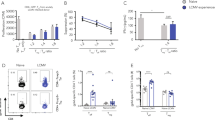Abstract
Arising from: V. Vezys et al. Nature 457, 196–199 (2009)10.1038/nature07486; Vezys et al. reply
An important role for the immune system is to maintain protective immunological memory to a wide variety of pathogens encountered over one’s lifetime, while still leaving the host able to respond to newly encountered pathogens. Vezys et al.1 make the interesting observation that it is possible to repeatedly immunize mice in ways that allow for development of high numbers of memory CD8 T cells without depleting pre-existing memory cells specific for other pathogens. This study, which offers promise in developing potent vaccination schemes, is seemingly at odds with work published by us in the 1990s showing a loss in CD8 memory cells after a series of infections2,3. In their reply, Vezys et al. mention that we may have misinterpreted our data because we reported the putative loss of memory T cells as per cent rather than total number, but here we represent the data in those studies as total cell number2,3,4. We show here in Fig. 1 that a series of infections can indeed reduce the total number of memory cells, indicating that vaccination strategies need to consider this issue.

Total numbers of lymphocytic choriomeningitis virus (LCMV)-epitope-specific CD8 T cells per spleen in mice immune to LCMV and subsequently infected with Pichinde virus (PV), vaccinia virus (VV), murine cytomegalovirus (MCMV) or vesicular stomatitis virus (VSV). Data are reworked from refs 3 and 4. These are controlled experiments in which all measurements were taken at the same time after LCMV infection. a, Attrition of LCMV-specific memory cells as measured by limiting dilution assays after sequential virus infections. b, Attrition of LCMV-specific memory cells as measured by MHC-dimer or intracellular IFN-γ assays after sequential virus infections. Combined frequencies of T cells specific to LCMV-encoded epitopes NP396, GP33/34 and GP276 (GP, glycoprotein; NP, nucleoprotein).
Similar content being viewed by others
References
Vezys, V. et al. Memory CD8 T-cell compartment grows in size with immunological experience. Nature 457, 196–199 (2009)
Selin, L. K., Vergilis, K., Welsh, R. M. & Nahill, S. R. Reduction of otherwise remarkably stable virus-specific cytotoxic T lymphocyte memory by heterologous viral infections. J. Exp. Med. 183, 2489–2499 (1996)
Selin, L. K. et al. Attrition of T cell memory:selective loss of lymphocytic choriomeningitis virus (LCMV) epitope-specific memory CD8 T cells following infections with heterologous viruses. Immunity 11, 733–742 (1999)
Varga, S. M., Selin, L. K. & Welsh, R. M. Independent regulation of lymphocytic choriomeningitis virus-specific T cell memory pools: relative stability of CD4 memory under conditions of CD8 memory T cell loss. J. Immunol. 166, 1554–1561 (2001)
Kim, S. K. & Welsh, R. M. Comprehensive early and lasting loss of memory CD8 T cells and functional memory during acute and persistent viral infections. J. Immunol. 172, 3139–3150 (2004)
Smith, D. K. et al. Cross-reactive antigen is required to prevent erosion of established T cell memory and tumor immunity: a heterologous bacterial model of attrition. J. Immunol. 169, 1197–1206 (2002)
McNally, J. M. et al. Attrition of bystander CD8 T cells during virus-induced T cell and interferon responses. J. Virol. 75, 5965–5976 (2001)
Jiang, J., Lau, L. L. & Shen, H. Selective depletion of nonspecific T cells during the early stage of immune responses to infection. J. Immunol. 171, 4352–4358 (2003)
Bahl, K. et al. Interferon-induced attrition of CD8 T cells in the presence or absence of cognate antigen during the early stages of viral infections. J. Immunol. 176, 4284–4295 (2006)
Jiang, J., Gross, D., Nogusa, S., Elbaum, P. & Murasko, D. M. Depletion of T cells by type I interferon: differences between young and aged mice. J. Immunol. 175, 1820–1826 (2005)
Dudani, R., Murali-Krishna, K., Krishnan, L. & Sad, S. IFN-γ induces the erosion of preexisting CD8 T cell memory during infection with a heterologous intracellular bacterium. J. Immunol. 181, 1700–1709 (2008)
Hammarlund, E. et al. Duration of antiviral immunity after smallpox vaccination. Nature Med. 9, 1131–1137 (2003)
Author information
Authors and Affiliations
PowerPoint slides
Rights and permissions
About this article
Cite this article
Welsh, R., Selin, L. Attrition of memory CD8 T cells. Nature 459, E3–E4 (2009). https://doi.org/10.1038/nature08091
Received:
Accepted:
Issue Date:
DOI: https://doi.org/10.1038/nature08091
- Springer Nature Limited
This article is cited by
-
Clonal expansion of innate and adaptive lymphocytes
Nature Reviews Immunology (2020)
-
Interactions between innate and adaptive lymphocytes
Nature Reviews Immunology (2014)
-
Vezys et al. reply
Nature (2009)





